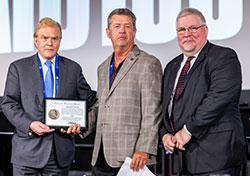 |
Thaddeus Sendzimir (left) and Barry Schneider (right) presented the 2024 AIST Tadeusz Sendzimir Memorial Medal for Innovation in Steel Manufacturing Technology to Ian Deeks (center), on behalf of Donald Lorento. |
Tadeusz Sendzimir Memorial Medal for Innovation in Steel Manufacturing Technology
►Nomination Form
►Award Recipients
History and Purpose
The AIST Tadeusz Sendzimir Memorial Medal for Innovation in Steel Manufacturing Technology was established in 1990 to perpetuate the memory of Dr. Tadeusz Sendzimir’s achievements and engineering contributions in developing process equipment for the steel industry.
Nomination Process
Nominations shall be made by submitting the AIST Award Nomination Form. The principal nominator must be a member of an AIST Technology Committee. One of three required letters of endorsement must be from the Technology Committee chair, or his or her designated representative, and must be submitted along with a detailed biography and citation.
All nomination information is considered confidential to the AIST Board of Directors, the Awards & Recognition Program Committee and its subcommittees.
Qualifications
The award shall be given to the individual or individuals who have advanced steelmaking through the invention, development or application of new manufacturing processes or equipment. Posthumous nominations shall be eligible if nominated within three years of death.
Selection Process
The AIST Awards and Recognition Program Committee will select a final candidate.
About Tadeusz Sendzimir
 Tadeusz Sendzimir was a Polish engineer and inventor of international renown with 120 patents in mining and metallurgy, 73 of which were awarded to him in the United States.
Tadeusz Sendzimir was a Polish engineer and inventor of international renown with 120 patents in mining and metallurgy, 73 of which were awarded to him in the United States.
Sendzimir was a holder of the Polish Golden Cross of Merit, the Bessemer Gold Medal and the Brinell Gold Medal from the Royal Swedish Academy of Sciences. The AIST Tadeusz Sendzimir Memorial Medal was established in 1990.
After studying at the 4th Classical Gymnasium in Lwów, Poland, Sendzimir entered the Politechnika Lwowska. When Lwów was captured by Russian troops, the Polytechnic Institute was closed and he moved to Kiev. There he worked in auto services and in the Russian-American Chamber of Commerce. The Russian Revolution of 1917 forced Sendzimir to flee to Shanghai, where he built the first factory in China that produced screws, nails and wire.
Designing and making his own machines, Sendzimir began experimenting with a new way to galvanize steel. Despite galvanization, the products still had a tendency to oxidize. Sendzimir discovered that the problem was due to the zinc bonding to a thin layer of iron hydroxide on its surface, rather than to the iron. In 1931, he obtained support for the construction of the first industrial-scale galvanizing unit and put several cold strip mills into operation.
He established a steel mill in Butler, Pa., USA, in 1936. By 1938, Armco Steel became interested in his work and formed the Armzen Co. with him to oversee the worldwide expansion of his galvanizing and mill technology. Sendzimir's patented mill could roll hard materials down to very light gauges.
The T. Sendzimir Inc. company was formed in Waterbury, Conn., in the 1940s.
In 1975, Sendzimir received the honorary degree of doctor honoris causa from the AGH University of Science and Technology in Kraków, Poland. Sendzimir's successful methods for galvanizing steel eventually were implemented in the first Z-mill rolling silicon steel, and by the 1980s, 90% of the world’s galvanized steel production went through the Sendzimir process.
Sendzimir died in 1989 after a massive stroke and was buried by his family in a zinc-plated coffin made according to his design.
